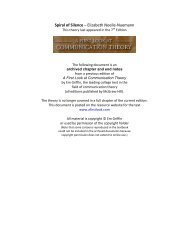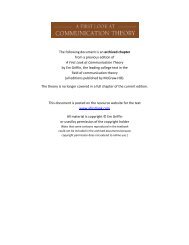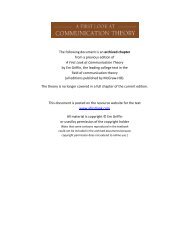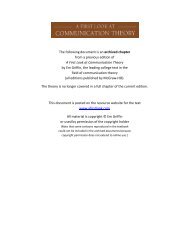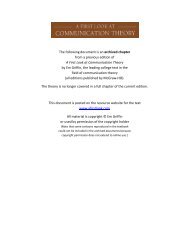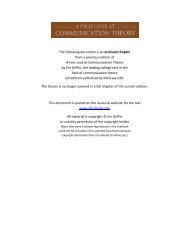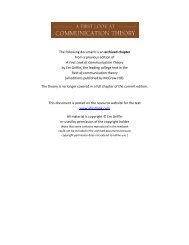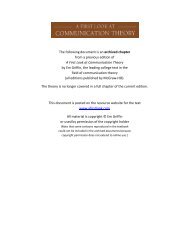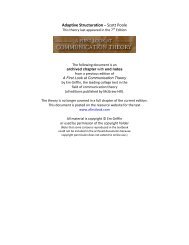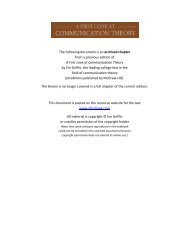Action Assembly Theory (PDF) - A First Look at Communication Theory
Action Assembly Theory (PDF) - A First Look at Communication Theory
Action Assembly Theory (PDF) - A First Look at Communication Theory
You also want an ePaper? Increase the reach of your titles
YUMPU automatically turns print PDFs into web optimized ePapers that Google loves.
122 CHAPTER 11<br />
by any single empirical study. He has expressed a fear of cre<strong>at</strong>ing a simplistic<br />
theory th<strong>at</strong> fails to capture the complexity of the mind. He need not have worried.<br />
But most students who invest the effort to understand Greene’s ideas conclude<br />
th<strong>at</strong> he has closely approxim<strong>at</strong>ed wh<strong>at</strong> is really going on in the mind.<br />
A SECOND LOOK<br />
Recommended resource: John Greene, “<strong>Action</strong> <strong>Assembly</strong> <strong>Theory</strong>: Met<strong>at</strong>heoretical<br />
Commitments, Theoretical Propositions, and Empirical Alloc<strong>at</strong>ions,” in Reth’rzking Communic<strong>at</strong>ion,<br />
Vol. 2, Brenda Dervin, Lawrence Grossberg, Barbara J. O’Keefe, and Ellen<br />
Wartella (eds.), Sage, Newbury Park, Calif., 1989, pp. 117-128.<br />
Original st<strong>at</strong>ement: John Greene, “A Cognitive Approach to Human Communic<strong>at</strong>ion:<br />
An <strong>Action</strong> <strong>Assembly</strong> <strong>Theory</strong>,” Communic<strong>at</strong>ion Monographs, Vol. 51, 1984, pp. 289-<br />
306.<br />
Further development: John Greene, “The Stability of Nonverbal Behavior: An<br />
<strong>Action</strong>-Production Approach to Problems of Cross-Situ<strong>at</strong>ional Consistency and Discrimin<strong>at</strong>iveness,”<br />
Journal of Language and Social Psychology, Vol. 8, No. 3, 1989, pp. 193-<br />
200.<br />
Pauses as signs of thought: John Greene, Sandi Smith, Ruth Smith, and Joan<br />
Cashion, “The Sound of One Mind Working: Memory Retrieval and Response Prepar<strong>at</strong>ion<br />
as Components of Pausing in Spontaneous Speech,” in Communic<strong>at</strong>ion Yearbook<br />
10, Margaret McLaughlin (ed.), Sage, Beverly Hills, 1987, pp. 241-258.<br />
Speech prepar<strong>at</strong>ion study: John Greene, “Speech Prepar<strong>at</strong>ion Processes and Verbal<br />
Fluency,” Human Communic<strong>at</strong>ion Research, Vol. 11, 1984, pp. 61-84.<br />
Deception study: John Greene, H. D. O’Hair, Michael Cody, and C<strong>at</strong>herine Yen,<br />
“Planning and Control of Behavior During Deception,” Human Communic<strong>at</strong>ion Research,<br />
Vol. 11, 1985, pp. 335-364.<br />
Cognitive theo y evalu<strong>at</strong>ion: John Greene, “Evalu<strong>at</strong>ing Cognitive Explan<strong>at</strong>ions of<br />
Communic<strong>at</strong>ive Phenomena,” Quarterly Journal of Speech, Vol. 70, 1984, pp. 241-254.<br />
Measures of cognitive process: John Greene, “Cognitive Processes: Methods for<br />
Probing the Black Box,” in A Handbook for the Study of Human Communic<strong>at</strong>ion,<br />
Charles Tardy (ed.), Ablex, Norwood, NJ., 1988, pp. 37-66.



